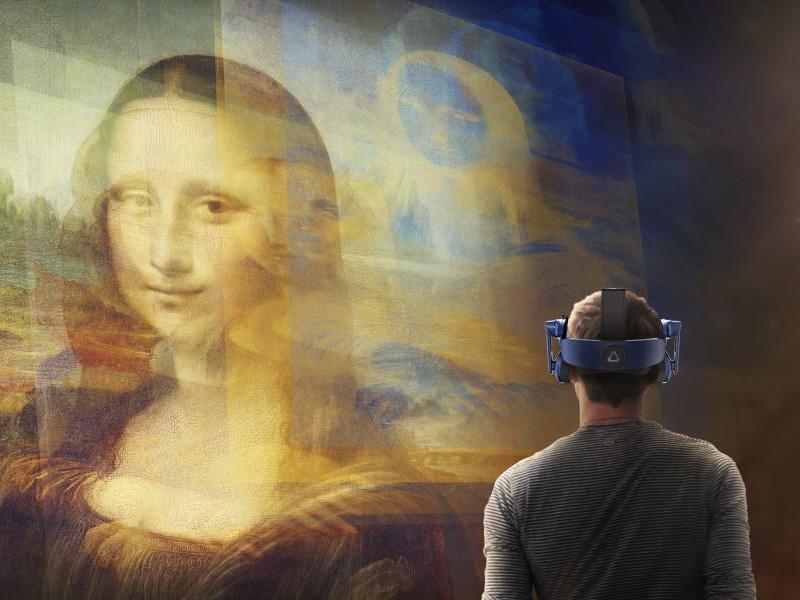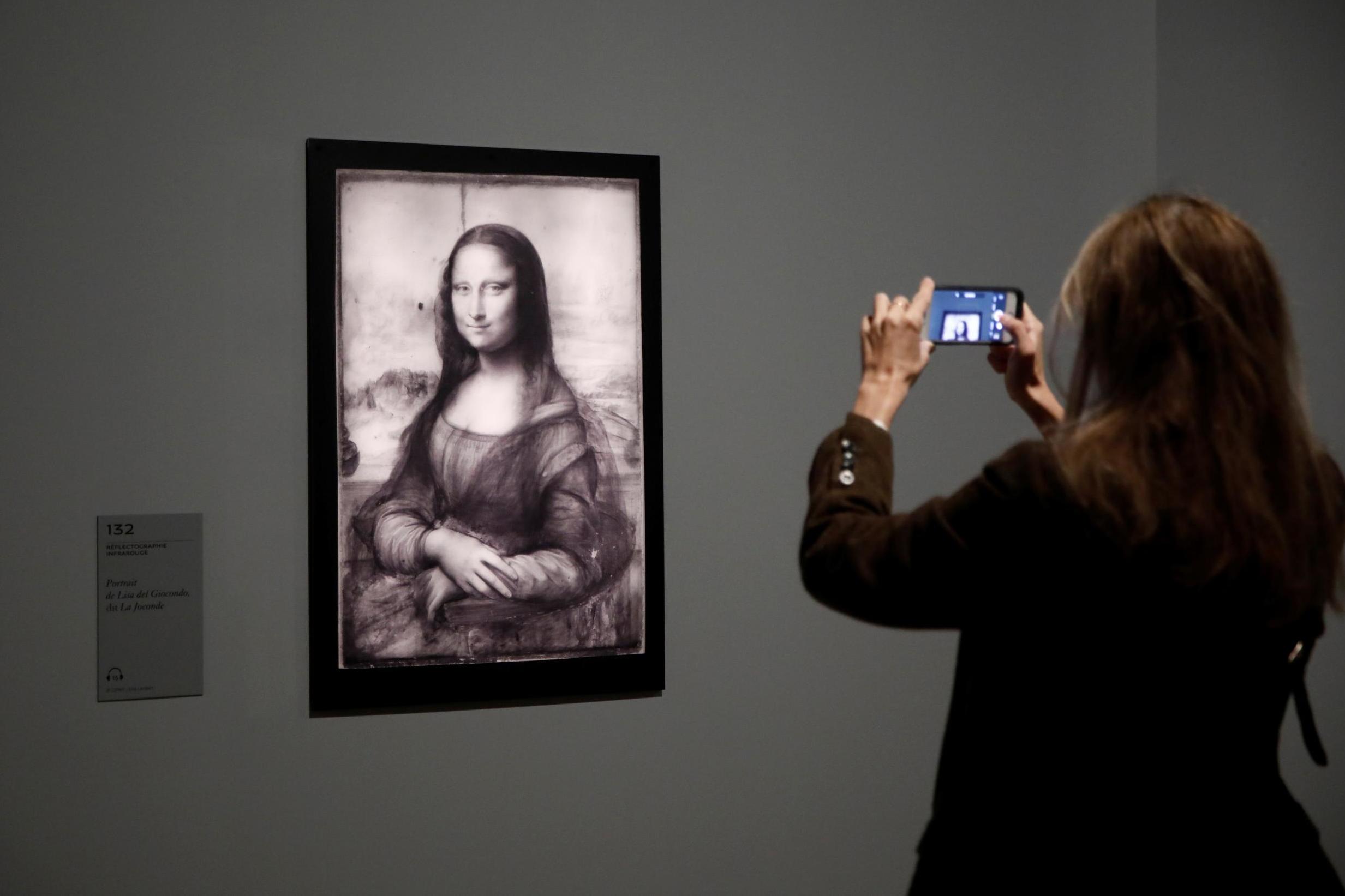500 years after the death of Leonardo da Vinci, the Mona Lisa is getting a virtual-reality makeover
How can you bring the most famous painting in the world to a new audience? Doreen Carvajal finds out

Mona Lisa’s lingering smile remains the same, but she is getting a first-of-its-kind virtual makeover from the Louvre, which has struggled this year with the popularity of Leonardo da Vinci’s masterpiece and the throngs of selfie-snapping tourists.
With a blockbuster Leonardo exhibition fast approaching, the Louvre and its production partners are fine-tuning a virtual-reality tour with three-dimensional views of the portrait that look beyond the jostling crowds, the shatterproof glass case and the layers of varnish from restorations and the fading green patina.
The real oil on wood Mona Lisa was returned last week to the skylit Salle des États, to coincide with yesterday’s opening of an exhibition marking the quincentennial of the death in 1519 of Leonardo, master of the Italian renaissance. During the summer, while the Salle des États was being renovated, the portrait was moved to the Galerie Médicis, which resulted in severe overcrowding because of limited access. Disappointed tourists complained about fleeting glimpses and barriers that kept them about 15 feet from the 30-inch-tall painting.
The virtual-reality tour will be a more intimate encounter. The VR tour, designed to remedy the problem of crowds and distance, will be housed in a small gallery room near the main Leonardo exhibition and apart from the Mona Lisa.
The gallery, equipped with 15 headset stations, will offer seven-minute virtual tours that begin in a familiar crush of visitors with mobile phones aloft. They lead through a gallery of paintings to the portrait of Mona Lisa, the wife of an Italian silk merchant.
“She is seated, and spectators will be facing her like a conversation, face to face,” says Dominique de Font-Réaulx, the Louvre’s director of mediation and cultural programming.
In this virtual land of Leonardo, spectators eventually fly over a valley and jagged hills aboard a wing-flapping glider he sketched (and which appears in the traditional exhibition). De Font-Réaulx notes that the two curators of the main exhibition have researched all the historical information for the virtual tour narration, including the visual details of Mona Lisa and her surroundings – from the gentle wave of her hair to her velvet dress to the clay tiles of the loggias of 16th-century Florence.

The digital experiment is part of an ongoing effort to broaden the Louvre’s appeal, with France laying new plans to promote its art treasures with virtual-reality tours and some lower-tech alternatives.
In September, Franck Riester, France’s minister of culture, unveiled a project to develop a thousand “micro-follies”, or digital pop-up museums, over the next three years in rural and suburban locations – including cinemas, libraries, social centres and even hair salons. France intends to spend €3m (£2.6m) to offer virtual-reality and 2D digital tours to show off the masterworks of a dozen major Paris museums, including, potentially, the Louvre’s Mona Lisa tour.
Not everyone is thrilled with this campaign to make virtual reality a more fundamental part of the museum experience. “I would prefer the Louvre to be involved with reality,” says Didier Rykner, a French art critic and founder of the website La Tribune de l’Art, who argues that the state’s money is better spent on art acquisitions and that the museum should concentrate on organisational issues to reduce crowding.
“It’s patronising. It’s disdain. Everywhere in France you have users and churches and monuments where you can find big art – like a Velázquez or a Caravaggio,” Rykner says. “With €3m, you could buy three masterpieces that you could give to the museums in France, so it would be real art for real people.”
But other major museums are already experimenting with VR and are pushing forward based on the results. Earlier this year, the Musée de l’Orangerie in Paris tried out a virtual-reality tour inspired by Monet’s Water Lily series that plunged spectators into the artist’s virtual pond in his Giverny garden through animated snowfall and summer days.

The reaction of visitors has impressed Louvre officials. “Not only young people were using it. There were people over 65, including my father, who is 83,” says De Font-Réaulx, of the Louvre. “It’s very interesting, and we are open to new displays. But it will not replace the works. The content is first. That’s very important to the Louvre.”
HTC Vive Arts, which is donating its services to develop the Louvre’s Mona Lisa project, also coordinated the production of the Monet tour along with a VR programme last year at the Tate Modern in London, created to accompany an exhibition devoted to Amedeo Modigliani.
There the curators used historical research to reimagine the interior of Modigliani’s 1919 Paris studio in vivid detail, down to a cigarette smouldering on the table and rain from a roof leak dripping into a bucket.
“What was wonderful was that many people spent more time looking at the Modigliani self-portrait in the last room of the exhibition,” says Nancy Ireson, a curator of the Modigliani exhibition. “They understood what they were going to see. They stayed longer and had conversations about the portrait.”
Since that project, Ireson has moved on to the Barnes Foundation in Philadelphia as a deputy director of collections. The Barnes has instituted a programme that brings basic headsets to local libraries to promote its collection of impressionist works, then offers free bus rides and museum tickets for the following week. About 50 per cent of the participants have used the free passes, according to Ireson.
Paris museum officials are optimistic that the Louvre’s experiment will open the museum “to a new public, which is maybe not interested in artworks, but is interested in the experience of VR”, according to De Font-Réaulx, who notes that viewers will be able to download the tour from home and that it could also travel in the future as a pop-up exhibition for symposiums and salons.
In preparation for today, the Louvre has taken steps to minimise lines to glimpse its virtual Mona Lisa. Reservations are required.
© New York Times
Join our commenting forum
Join thought-provoking conversations, follow other Independent readers and see their replies
Comments
Bookmark popover
Removed from bookmarks